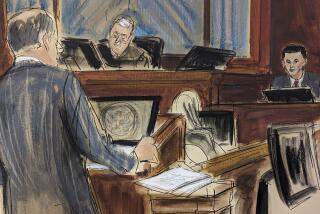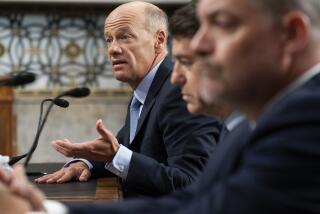Bank Examinations--System Needing Repair
- Share via
As financial markets become more deregulated and banks undertake riskier ventures for which they have no historical experience, the stability of the financial system is more dependent than ever on sound bank examinations. The current system, which is incompetent and rife with conflict of interests, requires reform.
The process of bank examination in the United States, entrusted to the Comptroller of Currency and the Federal Reserve, has broken down. Bank examiners have stood aside while traditional rules of sound banking have been discarded. In some instances examiners have pushed unsound banking practices on banks. Banking problems in Chicago, Oklahoma and Texas are evidence that bank examinations have become virtually worthless.
Moreover, in recent years the Federal Reserve, which is responsible for examining state-chartered member banks, has created a conflict of interest for itself that undermines its ability to perform an honest examination in some instances. During the 1980s banks that refused to lend money to Third World governments to pay interest on their existing indebtedness were requested by Federal Reserve officials to reconsider. Such circumstances make it impossible for a bank examiner to criticize a loan requested by the Fed or a comparable one made without the Fed’s intervention. The overall impact is to lower examination standards.
The Federal Reserve should be relieved of its examining responsibilities. These responsibilities should be given to the Federal Deposit Insurance Corp., which, as the agency responsible for insuring the banks’ deposits, has the strongest incentive to keep banks out of trouble. As the FDIC does not conduct monetary policy, it does not have the enormous scope for conflict of interest that bedevils the Fed. The comptroller’s office, with beefed-up capacity, should continue with the responsibility for examining national banks.
Some dispute our view, claiming instead that such practices as lending money to pay interest simply round-trip the funds to the bank, thus preventing technical default rules from causing a crisis. However, when a bank increases a loan in order to receive interest, it leaves its balance sheet in a weaker position. The round-tripped funds are added to profits, which are subject to taxation and to any profit-sharing or bonus program based on earnings. By lending money to pay interest, banks add more to their problem loans than they are able to retain from the interest received.
In a world in which solutions to problems often consist of weakening the standards of the past, our criticisms may seem dogmatic. However, the evidence of problem banks is everywhere. Taxpayer bailout of bankrupt savings-and-loan associations is now estimated to cost $100 billion.
If bank examiners had enforced standards, the problems afflicting our financial institutions would not have materialized. However, during a period when bank lending exploded in proportion to bank capital, examinations became increasingly meaningless and in some cases perverse. Banks were even required by law to reduce their reserve for bad debts.
The availability of funds in the Euro-dollar market together with the increase in the guaranty of deposits by the FDIC made it possible for commercial banks to increase their lending. By 1970 many banks’ loans exceeded 10 times their capital--an all-time high. This beginning was followed by a real explosion in the loan-to-capital ratio as a result of lending to Third World governments and government-sponsored agencies. Total loans of some major banks swelled to 30 times their capital. Only when this occurred together with evidence that Third World countries were having difficultly with their debts did the Federal Reserve suggest that banks should increase their capital.
The financial problem in the banking sector is primarily the responsibility of bank managers. However, these problems developed over a period of years, and if the examining authorities had done their job, unsound practices would have been halted before they became major problems. One of the basic rules of banking is that no bank should lend more than 10% of its capital to any one borrower. Yet 80% of the loans to several Third World countries went to government entities and totaled more than 50% of the capital of some banks. The examiners obviously approved this unsound concentration of lending.
In the 1980s prudent bank management has brought criticism from the comptroller’s office for not showing sufficient profits. In one case a bank that cleaned up its investments, charged off all non-performing loans, built a bad-debt reserve of 3% of loans outstanding and maintained a capital base of 9% of total assets drew the ire of the examiner. This is not an extreme or isolated example.
The breakdown in bank examinations has coincided with the public’s lack of attention to the quality of management of institutions in which they place funds. Fraud and risky lending practices have multiplied, especially among S & Ls, but depositors, protected by federal guarantees, have had no incentive to monitor the management of their financial institutions or to remove their funds from risky S & Ls.
It may be the case that no one any longer knows what sound banking practices are. On the other hand, major accounting firms might have senior partners who could establish training programs for the comptroller and the FDIC that would refurbish the process of bank examination and make it again contribute to the security of our financial institutions. In these days of so much talk about cooperation between the public and private sectors, this is one that might be worthwhile exploring.
More to Read
Inside the business of entertainment
The Wide Shot brings you news, analysis and insights on everything from streaming wars to production — and what it all means for the future.
You may occasionally receive promotional content from the Los Angeles Times.










